This Persian dolmeh recipe is a traditional Iranian recipe and a family favorite. This version of stuffed grape leaves is made with meat, rice and herbs.
I hope by now, you are a fan of Persian recipes as much as we are. From quick recipes such as one pan tomato rice or potato patties to ones that take more time like ghormeh sabzi, we have so many traditional Iranain dishes on the blog. Today's recipe is one of my all time favorites, Persian dolmeh recipe aka stuffed grape leaves. These are made the Iranian way which is different from what you've had at Mediterranean or Middle Eastern restaurants.
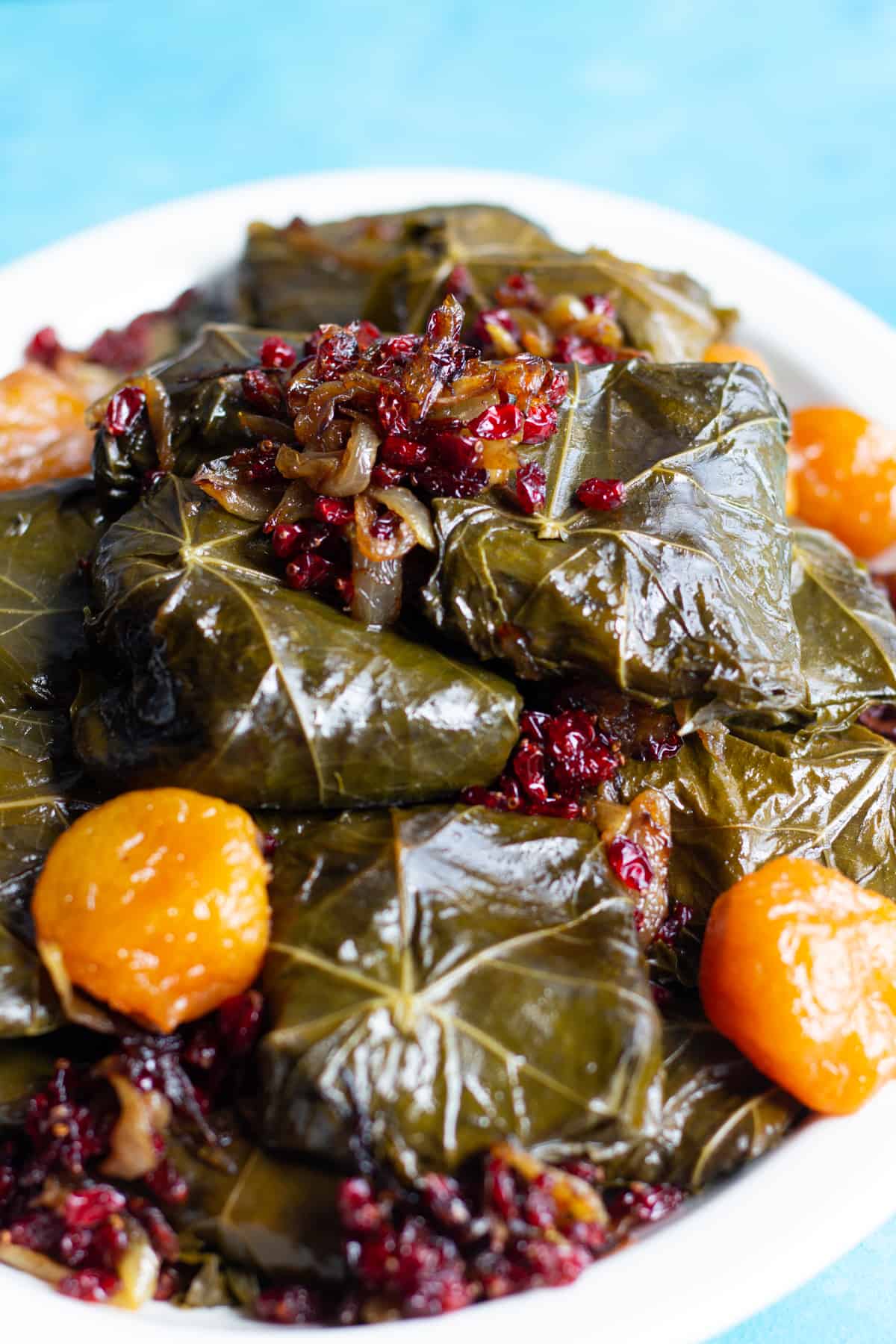
What is dolmeh?
Dolmeh comes from the word dolma which comes from the Turkish word Dolmak meaning "to fill". The word dolmeh refers to any vegetable that is stuffed. When refering to stuffed grape leaves, the full name of this dish is dolmeh barg mo which literally means stuffed grape leaves.
Dolmeh is a traditional Iranian dish that goes all the way back to the 17th century. Making dolmeh or dolma is common in Iran, Iraq, Syria, Turkey, Greece and Azerbaijan. Even though all these countries have dolmeh in common, each has their own recipe and ingredients.


What's the difference between Persian dolmeh and Turkish dolma?
Although stuffed grape leaves are a common delicacy in the Mediterranean and the Middle East, each country in the region has its own popular recipe to make dolmeh/dolma. Persian dolmeh uses ground meat whereas the Turkish version is vegetarian. As for the cooking method, Persian dolmeh recipe uses water and vinegar (or lemon juice) whereas Turkish dolma calls for vegetable oil and boiling water. Last but not leaste, Persian dolmeh is wrapped into a square form but Turkish and Greek dolmades are rolled.
Persian dolmeh has more ingredients for the filling such as yellow split peas and barberries. Turkish dolma on the other hand has simpler ingredients and is made with rice and herbs.
Ingredients to make Persian dolmeh recipe
Persian dolmeh recipe calls for more ingredients compared to its Mediterranean type. Common ingredients to make dolmeh are:
- Grape leaves
- Onion
- Garlic
- Ground beef
- Rice
- Yellow split peas or chana dal
- Salt and pepper
- Herbs such as tarragon, parsley, cilantro, green onion and fresh dill
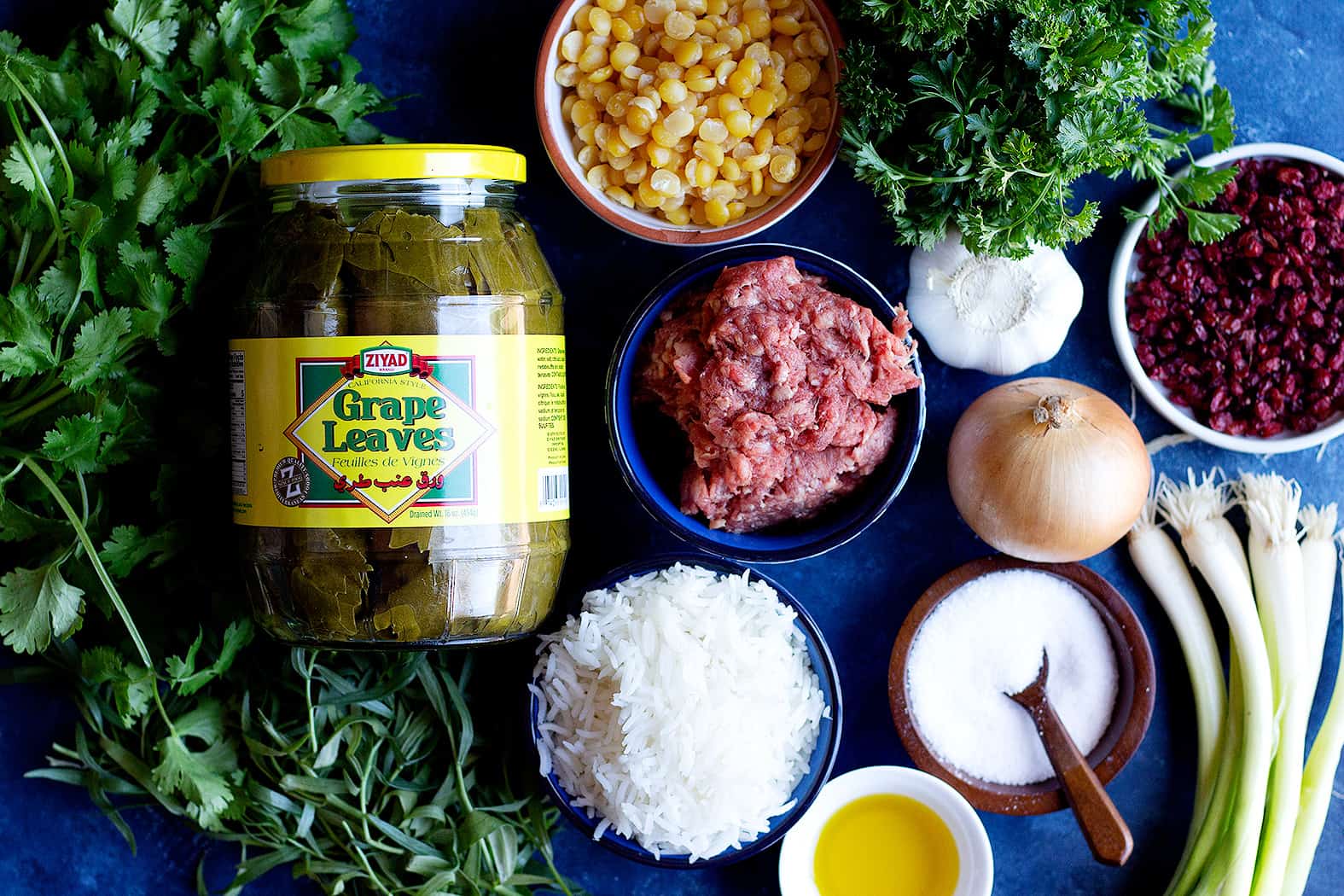
Since we use long grain rice when making Persian stuffed grape leaves, it's best to par-cook the rice before adding it to the filling. If the rice is not cooked partially, it becomes too large when the dolmeh is cooking.
As for split chickpeas, you can find them at Indian, Iranian or Mediterraneans shops. Look for chana dal in the dried legumes section. It's best to cook chana dal before adding it to the rest of the filling since it can take longer to cook.
Everything you need to know about grape leaves
In Iran, my maman would buy fresh grape leaves and use them to make Persian dolmeh recipe. Fresh grape leaves are light green and tart. When choosing fresh leaves to make dolmeh, you need to make sure that the leaves are large enough, ideally the size of your hand. If using fresh grape leaves, you need to blanch them in boiling water and salt to make sure they're soft enough to wrap when you stuff them. You can read more about fresh vine leaves and what to do with them on the SpruceEats.
These days you can find jarred grape leaves in supermarkets and Turkish or Middle Eastern shops. Jarred vine leaves are pre-blanched and ready to be rolled. I prefer using jarred grape leaves because they make the process faster and also because they are the right size for dolmeh.
Please watch the video to make sure you understand all the steps mentioned on how to make Persian stuffed vine leaves at home.
How to make Persian dolmeh recipe
- Make the filling: Heat some olive oil in a pan over medium heat. Saute onion and garlic until golden brown. Add in the ground beef and brown it. Add cooked chana dal and par cooked rice to browned ground beef. Stir in the herbs and cook for a few minutes. Finally, add the barberries and cook for a few minutes, stirring occasionally.
- Wrap the dolmeh: Lay a grape leaf flat on your working surface, rough side up. If the grape leaf has deep edges, place another grape leaf on top so you have a bigger surface to work with. Spoon some of the filling (about one tablespoon) in the middle of the leaf. Carefully, fold the edges from the sides and overlap to cover the filling and wrap the dolmeh into a square. (watch the video for instructions).
- Layer in the pot: Pour 1 tablespoon vegetable into a pot and cover the bottom with grape leaves. This is to prevent dolmeh from burning. Place the stuffed grape leaves tightly next to each other, overlapping side down. Repeat this step until the bottom of the pot is covered. Make sure the stuffed grape leaves are tightly set next to each other, to make sure they won't open up while cooking. Repeat the layers until every dolmeh is in the pot.
- Cook: Place a heat proof plate or a sauce pan lid on top of the dolmeh and press a bit. This is to make sure every piece is tightly sitting next to another and there is no space between them to move or open up. Mix1 ½ cup hot water with lemon juice and sugar and pour it into the pot from the edges and place the pot on medium heat and put the lid on. Once the water starts simmering, lower the heat and let the dolmeh cook for about one hour. After one hour, the water must be all absorbed and grape leaves should be cooked. Try one dolmeh; if it's soft, easy to bite and the rice is cooked completely, then it's ready to serve.

How to serve dolmeh
The traditional Iranian way to serve dolmeh is to put them on a platter and top them with caramelized onions and barberries or cooked dried Persian golden plums. Azeri people on the north west of the country, especially Tabriz, where my dad is from, serve these stuffed vine leaves with plain yogurt or mast o khiar (Persian yogurt and cucumbers).

Is dolmeh eaten hot or cold?
You can serve dolmeh hot, cold or at room temperature. It's really a matter of preference. I love having them freshly cooked and warm, but I also love snacking on them when they're cold.
How to store stuffed grape leaves
If you have leftovers, simply put them in an airtight container and refrigerate for up to 5 days. You can also freeze cooked dolmeh in a freezer bag for up to 4 months. To serve, you can thaw them in the fridge overnight or in the microwave.
Notes and tips to make Persian stuffed grape leaves
- This is a time consuming recipe as you have to wrap each grape leaf individually. I suggest you double this recipe and make a big batch. You can freeze half of the cooked dolmeh to serve later.
- Not a fan or meat? Simply leave the ground beef out of the recipe and proceed. All the steps would be the same.
- I usually use two leaves for each dolmeh but you can also use one. Make sure you wrap the tightly so the filling doesn't come out when cooking. If using one leaf, the stuffed grapes leaves are going to be smaller.
- If you don't have fresh tarragon or fresh dill, use 1 tablespoon of dried tarragon and dried dill.
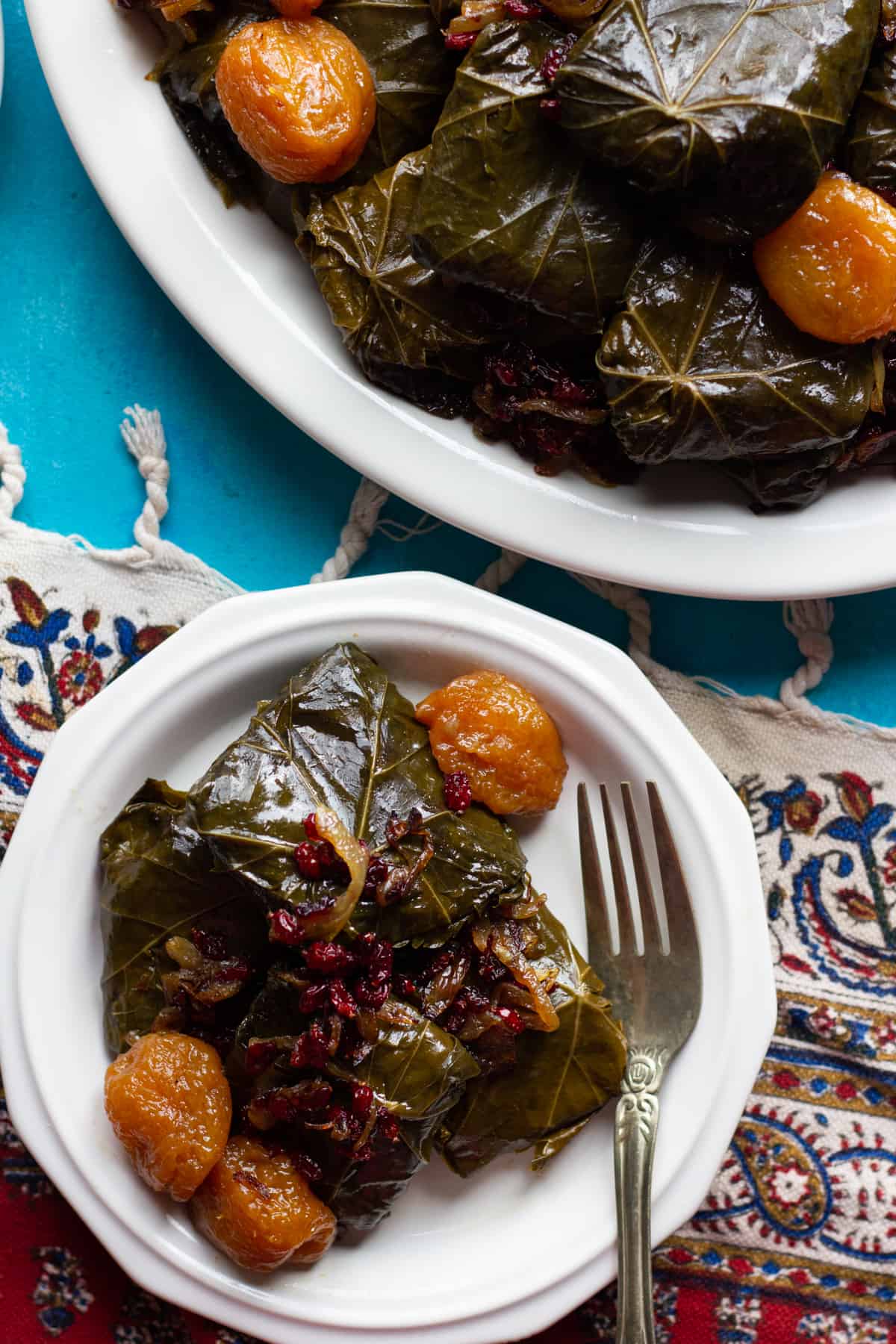
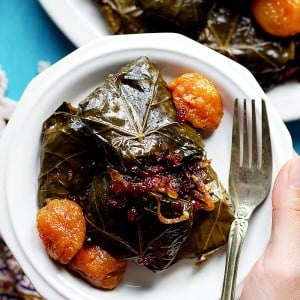
Persian Dolmeh Recipe
Ingredients
- 1 jar grape leaves 16 ounce
- 2 tablespoon olive oil
- 1 large onion finely chopped
- 2 cloves garlic minced
- ½ lb ground beef
- 1 cup basmati rice par-cooked
- ½ cup chana dal (yellow split chickpeas) cooked
- ½ teaspoon salt
- ¼ teaspoon black pepper
- ¼ cup fresh tarragon chopped
- ¼ cup parsley chopped
- ¼ cup cilantro chopped
- ⅓ cup green onion chopped
- ⅓ cup fresh dill chopped
- ½ cup barberries
- 1 ½ cup hot water
- 1 lemon juice of
- 1 tablespoon granulated sugar
Instructions
Make the filling:
- Heat olive oil in a pan over medium heat.
- Saute onion and garlic until golden brown. Add in the ground beef and brown it.
- Add cooked chana dal and par cooked rice to browned ground beef. Add salt and pepper.
- Stir in chopped tarragon, parsley, cilantro, green onion and dill and cook for a few minutes. Finally, add the barberries and cook for a few minutes, stirring occasionally.
Wrap the dolmeh:
- Lay a grape leaf flat on your working surface, rough side up. If the grape leaf has deep edges, place another grape leaf on top so you have a bigger surface to work with.
- Spoon one tablespoon of the filling in the middle of the leaf. Carefully, fold the edges from the sides and overlap to cover the filling and wrap the dolmeh into a square (watch the video for instructions). Carefully set it aside, folded side down.
Layer in the pot:
- Pour 1 tablespoon vegetable into a pot and cover the bottom with grape leaves.
- Place the stuffed grape leaves tightly next to each other, overlapping side down. Repeat this step until the bottom of the pot is covered.
- Make sure the stuffed grape leaves are tightly set next to each other, to make sure they won't open up while cooking. Repeat the layers until every dolmeh is in the pot.
Cook:
- Place a heat proof plate or a sauce pan lid on top of the dolmeh and press a bit.
- Mix 1 ½ cup hot water with lemon juice and sugar and pour it into the pot from the edges and place the pot on medium heat and put the lid on.
- When the water starts simmering, lower the heat and let the dolmeh cook for about one hour. After one hour, the water must be all absorbed and grape leaves should be cooked.
- Try one dolmeh; if it's soft, easy to bite and the rice is cooked completely, then it's ready to serve.
Video
Notes
- To par-cook rice, simply cook the rice in boiling water until it's soft on the outside and hard on the inside. This would take about 7-8 minutes if using basmati rice.
- IF fresh tarragon and dill isn't available, please use one tablespoon dried tarragon and one tablespoon dried dill.


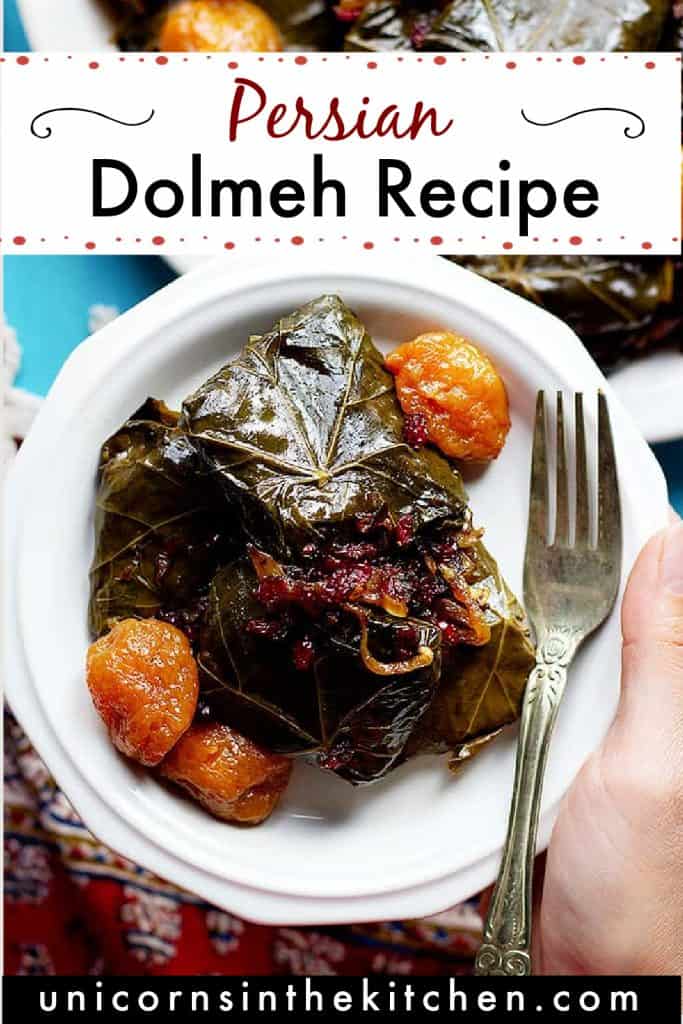
Theresa bloomquist
Amazing nice bold flavors all come together for a bright and tantalizing the taste buds just right! So worth the time to prepare!